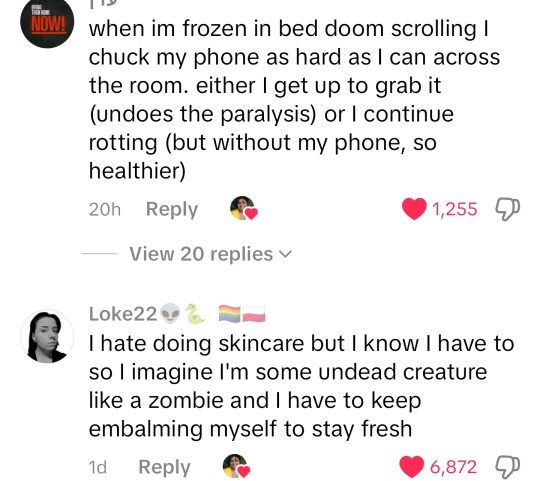Lucas | 26 | Dutch | They / Them | Type 1 Diabetic w/ Chronic Pain Syndrome (Including Chronic Fatigue) & Hypothyroidism
Don't wanna be here? Send us removal request.
Text
I've been disabled for almost 29 years. Here's what I've learned.
Tablets sink and capsules float. Separate out your tablets and capsules when you go to take them. Tip your head down when taking capsules and up when taking tablets. Liquigels don't matter, they kinda stay in the middle of whatever liquid is in your mouth.
If your pill tastes bad, coat it with a bit of butter or margarine. I learned this from my mom, who learned it from a pharmacist.
Being in pain every day isn't normal. Average people experience pain during exceptional moments, like when they stub their toe or jam their finger in a door, not when they sit cross-legged.
Make a medical binder. Make multiple medical binders. I have a small one that comes with me to appointments and two big ones that stay at home, one with old stuff and one with more recent stuff.
Find your icons. Some of mine include Daya Betty (drag queen with diabetes), Stef Sanjati (influencer with Waardenburg syndrome and ADHD), and Hank Green (guy with ulcerative colitis who... does a bunch of stuff). They don't have to be disabled in the same way as you. They don't even have to be real people. Put their pictures up somewhere if you want; I've been meaning to decorate my medical binders with pictures of my icons.
Take a bin, box, bag, basket, whatever and fill it with items to cope with. This can be stuff for mentally coping like colouring books or play clay or stuff for physically coping like pain medicine or physio tape.
Decorate your shit! My cane for at home has a plushie backpack clip hanging from the end of the handle and my cane for going places is covered in stickers. All of my medical binders have fun scrapbooking paper on the outside. Sometimes, I put stickers and washi tape on my inhalers and pill bottles. I used my Cricut to decorate my coping bin with quotes from my icons, like "I've seen enough of Ba Sing Se" and "I need you to be angrier with that bell".
If a flare-up is making you unable to eat or keep food down, consider going to the ER. A pharmacist once told me that since my eye flares can make me so nauseous that I cannot eat, then I need to go to the hospital when that happens.
Cola works wonders for nausea. I have mini cans of Diet Pepsi in my coping bin.
Shortbread is one of the only things I can eat when nauseous. Giant Tiger sells individually-wrapped servings of shortbread around Christmas or the British import store sells them year-round. I also keep these in my coping bin.
Unless it violates a pain contract or something, don't be afraid to go behind your doctor's back to get something they are refusing you. I got my cardiologist referral by getting in with a different NP at my primary care clinic than who I usually saw. I switched from Seroquel to Abilify by visiting a walk-in.
If you have a condition affecting your abdomen in some way (GI issues, reproductive problems, y'know) then invest in track pants that are too big. I bought some for my laparoscopy over a year ago and they've been handy for pelvic pain days, too. I've also heard loose pants are good for after colonoscopies.
Do whatever works, even if it's weird. I've sat on the floor of the Eaton Centre to take my pills. I've shoved heating pads down my front waistband to reach my uterus.
High-top Converse are good for weak ankles. I almost exclusively wear them.
You can reuse your pill bottles for stuff. I use my jumbo ones to store makeup sponges and my long skinny ones to hold a travel-size amount of Q-Tips.
Just because your diagnostics come back with nothing, it doesn't mean nothing is wrong. Maybe you were checking the wrong thing, or the diagnostic tool wasn't sensitive enough. I have bradycardia episodes even though multiple cardiac tests caught nothing. I probably have endometriosis even though my gynecologist didn't see anything.
You can bring your comfort item to appointments, and it's generally a green flag when someone talks to you about it. I brought a Squishmallow turkey (named Ulana) to my laparoscopy and they had her wearing my mask when I woke up. I brought a Build-A-Bear cat (named Blinx) to another procedure and a nurse told me that everyone in the hall on the way to the procedure room saw him and were talking about how cute he was. Both of those ended up being positive experiences and every person who talked to me about my plushies was nice to me. If you don't feel comfortable having it visible to your provider during the appointment, you can hide it in your bag and just know it's there, or if you're in a video appointment, you can hold it below frame in your lap.
Get a small bucket, fill it with stuff, and stick it in your bed (if you have room for it). I filled a bucket with Ensure, juice boxes, oatmeal bars, lotion, my rescue inhaler, etc. in October 2023 in anticipation of my laparoscopy and I still have it in my bed as of January 2025.
If your disability impacts your impulse control (e.g. ADHD, bipolar disorder), you should consider setting limits around your spending -- no more than X dollars at a time, nothing online unless it's absolutely necessary, and so on. Or, run these purchases by someone you trust before committing to them; I use my BFF groupchat to help talk sense into myself when I buy stuff.
Feel free to add on what you've learned about disability!
13K notes
·
View notes
Text
When you have a chronic ailment, you hear all the time “I could never.”
Oh, you cut out dairy/gluten/ect? I could never. Oh, you do self injections? I could never.
I could never deal with that much pain. I couldn’t live with all those doctor appointments. I could never stay in bed all day, I’d just get so bored! I couldn’t do it, I couldn’t live like that, can’t couldn’t wouldn’t…
Please stop implying to people with something chronic that you’d rather die than go through what they’re going through, and take a minute to understand that their treatment isn’t a hobby. It’s survival.
Yes, people with chronic ailments ARE incredibly strong. They ARE doing things you think you couldn’t ever do.
But they’re the same things that they likely thought they couldn’t ever do until they had no other option.
Yes. Often, someone with a chronic issue sees a notable decline in their quality of life.
That doesn’t make it less worth living.
You could do it if you had to.
“I could never” is not the empathetic response you think it is.
3K notes
·
View notes
Text
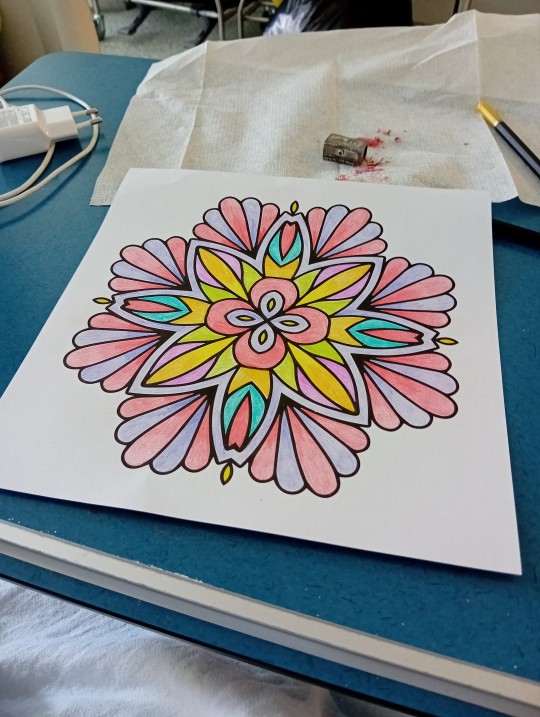
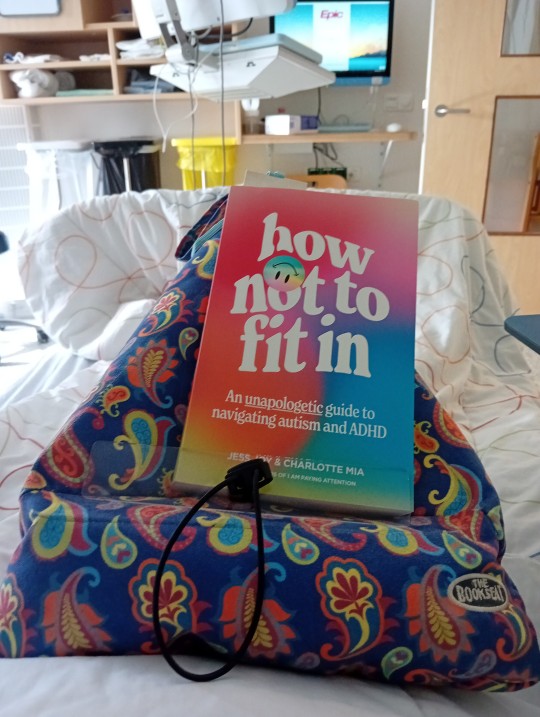

Hospital stay: 4 days on the ICU and 2 days on the MPU (Medical Psychiatric Unit)
Today is my last day in the hospital. Something out of my control happened and I ended up hospitalized and couldn't leave my bed. On the MPU I got more mobile and got off the glucose IV I was on the entire time.
I'm alright now!
0 notes
Text
Disability justice includes those who are disabled due to their own actions. You are not here to be blamed for what happened or why it did, you are here to receive love and support on your own journey.
4K notes
·
View notes
Text
It’s okay to have low pain tolerance.
It’s okay to cry because your pain is at a 2 out of 10.
It’s okay to have higher tolerance for certain types of pain and lower tolerance for others.
It’s okay to be upset that your pain makes you dissociate, but not know any other way to deal with it.
Chronic pain is awful, period. Everyone who deals with it deserves compassion.
4K notes
·
View notes
Text
heyyyyy reminder for other cane users.
don't forget that cane tips need to be replaced.
i've been using my cane for almost two years on a near daily basis and i JUST switched out the tip and
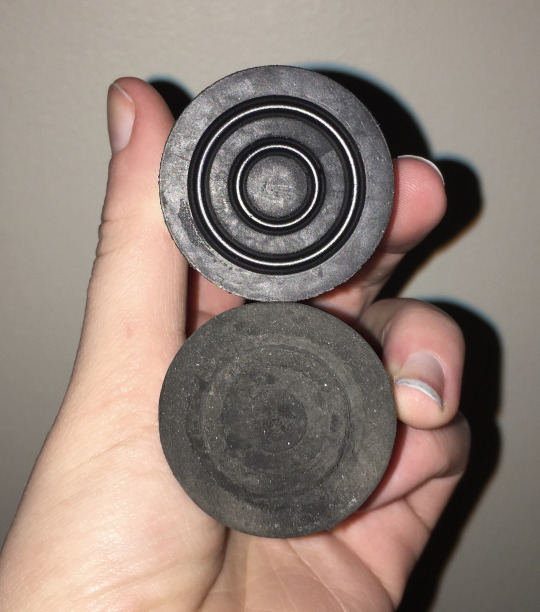

[image IDs in alt text]
the new tip versus the old tip. i'm not sure how clear it is but, YEAH, there's like. half a millimeter of tread left on the old tip, if that
the replacement was LITERALLY 2 dollars. i bought two to justify the four dollar shipping but. TWO BUCKS.
i had noticed that i was having slipping issues on linoleum recently, but i did not realize how bad the issue had gotten until the new tips came so. PLEASE check your cane treads and if they're notably worn out PLEASE get yourself a new tip they're SO cheap and the grip i get on the new one is INSANE
please don't forget to replace your cane tips!
28K notes
·
View notes
Text
I found an extremely dope disability survival guide for those who are homebound, bedbound, in need of disability accommodations, or would otherwise like resources for how to manage your life as a disabled person. (Link is safe)
It has some great articles and resources and while written by people with ME/CFS, it keeps all disabilities in mind. A lot of it is specific to the USA but even if you're from somewhere else, there are many guides that can still help you. Some really good ones are:
How to live a great disabled life- A guide full of resources to make your life easier and probably the best place to start (including links to some of the below resources). Everything from applying for good quality affordable housing to getting free transportation, affordable medication, how to get enough food stamps, how to get a free phone that doesn't suck, how to find housemates and caregivers, how to be homebound, support groups and Facebook pages (including for specific illnesses), how to help with social change from home, and so many more.
Turning a "no" into a "yes"- A guide on what to say when denied for disability aid/accommodations of many types, particularly over the phone. "Never take no for an answer over the phone. If you have not been turned down in writing, you have not been turned down. Period."
How to be poor in America- A very expansive and helpful guide including things from a directory to find your nearest food bank to resources for getting free home modifications, how to get cheap or free eye and dental care, extremely cheap internet, and financial assistance with vet bills
How to be homebound- This is pretty helpful even if you're not homebound. It includes guides on how to save spoons, getting free and low cost transportation, disability resources in your area, home meals, how to have fun/keep busy while in bed, and a severe bedbound activity master list which includes a link to an audio version of the list on Soundcloud
Master List of Disability Accommodation Letters For Housing- Guides on how to request accommodations and housing as well as your rights, laws, and prewritten sample letters to help you get whatever you need. Includes information on how to request additional bedrooms, stop evictions, request meetings via phone, mail, and email if you can't in person, what you can do if a request is denied, and many other helpful guides
Special Laws to Help Domestic Violence Survivors (Vouchers & Low Income Housing)- Protections, laws, and housing rights for survivors of DV (any gender), and how to get support and protection under the VAWA laws to help you and/or loved ones receive housing and assistance
Dealing With Debt & Disability- Information to assist with debt including student loans, medical debt, how to deal with debt collectors as well as an article with a step by step guide that helped the author cut her overwhelming medical bills by 80%!
There are so many more articles, guides, and tools here that have helped a lot of people. And there are a lot of rights, resources, and protections that people don't know they have and guides that can help you manage your life as a disabled person regardless of income, energy levels, and other factors.
Please boost!
24K notes
·
View notes
Text

[ID: a text sent by the user that reads: ‘I miss when being in this much pain was a serious concern and not my everyday life’]
462 notes
·
View notes
Text

This is a friendly reminder that none disabled people often do benefit from the same accommodations disabled people benefit from.
95K notes
·
View notes
Text
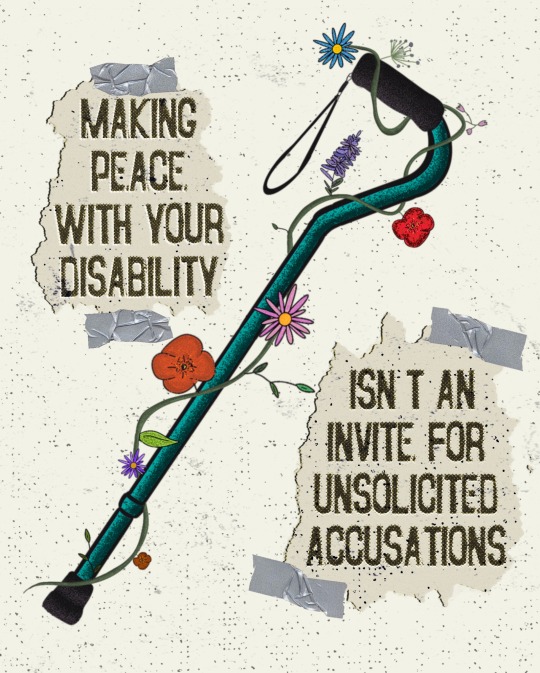
it’s fibromyalgia awareness month so I just wanted to say a lil somethin’
ig post here (includes full caption)
9K notes
·
View notes
Text
Remember that every time you use your mobility aid in public, there is very likely another person there who is too apprehensive to use their own mobility aid and feels braver from seeing you use yours.
4K notes
·
View notes
Text
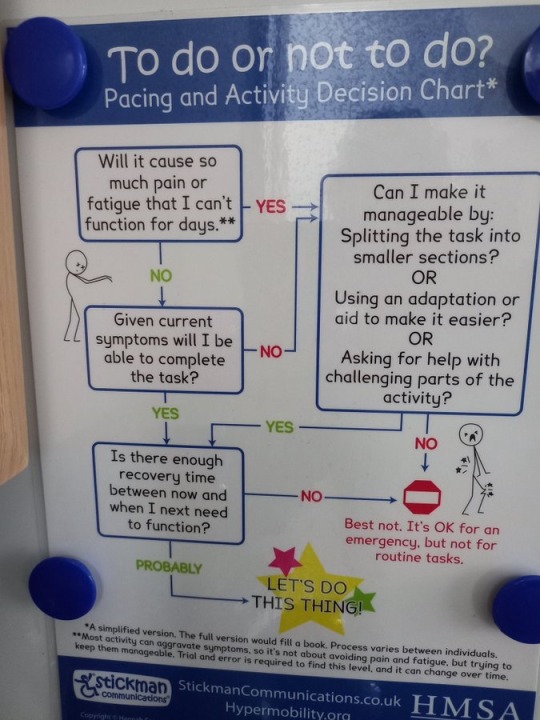
Alt Text / Image Description below
To do or not to do?
Pacing and Activity Decision Chart*
A. Will it cause so much pain or fatigue that I can't function for days?
If NO then :
B. Given current symptoms will I be able to complete the task?
(If you answer YES to question B go to D, if NO then go to C)
If YES then :
C. Can I make it manageable by:
Splitting the task into smaller sections?
OR
Using an adaptation or aid to make it easier?
OR
Asking for help with challenging parts of the activity?
(If you answer YES to C go straight to D)
D. Is there enough recovery time between now and when I next need to function?
If you answer YES/PROBABLY to D then LET'S DO
THIS THING!
If you answer NO to both question C and D then:
Best not. It's OK for an emergency, but not for routine tasks.
Disclaimer:
*A simplified version, The full version would fill a book. Process varies between individuals.
**Most activity can aggravate symptoms, so it's not about avoiding pain and fatigue, but trying to keep them manageable. Trial and error is required to find this level and it can change over time.
StickmanCommunications.co.uk (HMSA)
5K notes
·
View notes
Text
You know I’ve been thinking, there should be no guilt in experiencing happiness as a disabled or chronically ill person. We don’t need to suffer every waking moment to justify our experiences and our truths.
Joy is a universal right. And that includes us.
2K notes
·
View notes



